
Guests
- Rep. Maxine WatersDemocratic Congressmember from California serving in her seventh term. She is the Chief Deputy Whip of the Democratic Party and serves as Co-Chair of the House Democratic Steering Committee. She is the former chair of the Congressional Black Caucus.
Malfunctioning software in electronic voting machines has already caused confusion or possibly faulty vote tallies in races across the country. We speak with a San Diego poll worker about problems she witnessed with voting machines, a member of Pax Christi USA, which will send international monitors to observe the presidential election in Florida and a computer science professor who has led the charge calling for a paper trail to record votes. [includes transcript]
Sen. John Kerry of Massachusetts swept all four Southern Democratic primaries yesterday, winning about 77 percent of the votes in Florida and Mississippi and more than 65 percent in Louisiana and Texas. Many of the people that headed to the polls yesterday used electronic voting machines for the first time to cast their vote.
And in the upcoming presidential election, millions more American voters are projected to use electronic voting machines. But concerns over security flaws in voting machines have sparked wide-ranging public debate.
In one case, a special election to fill Florida state House seat 91, 134 Broward County voters managed to use 2-year-old touch-screen elecronic voting equipment without casting votes for any candidate.
Already, malfunctioning software has caused confusion or possibly faulty vote tallies in races across the country and the lack of a paper trail to record votes has failed to provide a way for a meaningful recount to be conducted.
Now for the first time, international monitors will be in the U.S. to make sure votes are cast and counted correctly. Members of the Catholic peace movement Pax Christi announced this week that they will post monitors at polling places around Florida during the Nov. 2 general election.
- Prof. David Dill, professor of computer science at Stanford University and founder of VerifiedVoting.org. He has led the charge to oppose the use of electronic voting equipment that do not allow voters to inspect individual permanent records of their ballots, fail to provide a means by which a meaningful recount may be conducted, or use software that is not open to public scrutiny.
- Jennifer Hamilton, 27-year-old poll worker in San Diego. Last night she testified at a town hall meeting in San Diego about problems she witnessed with electronic voting machines.
- Dave Robinson, national coordinator of Pax Christi USA. The organization has announced it will send international monitors to observe the presidential election in Florida.
Transcript
AMY GOODMAN: We’re going to turn first to Professor David Dill. He is a professor of Computer Science at Stanford university and founder of verifiedvoting.org. He’s led the charge to oppose the use of electronic voting equipment that doesn’t allow Voters to inspect permanent individual records of their ballots. Welcome to Democracy Now!
DAVID DILL: Thank you for having me on.
AMY GOODMAN: Good to have you with us. All right. Let’s start off with this case in Broward County. It happened when?
DAVID DILL: A recent election within the last couple of months.
AMY GOODMAN: And what happened?
DAVID DILL: There was an election. I think there were about 10,000 voters. There was only one office on the ballot with seven candidates. 134 voters went to the trouble of coming to the polls, signing in and got in front of the voting machines and then mysteriously didn’t cast votes. We heard lots of different plausible explanations, but nobody can find out for sure where those 134 votes went because there’s no independent check on the machines. I’ll mention also that in that election the margin of victory was only 12 votes. They tried to do a recount and discovered, surprise, there were no paper ballots to recount. They asked for advice from the State and the local officials complained that they couldn’t get an answer in writing. It was all kind of a farce.
AMY GOODMAN: And this was Florida?
DAVID DILL: Yeah, Broward county.
AMY GOODMAN: Can you talk overall about the situation of electronic voting? In a minute, we’re going to go to a poll worker, who interestingly enough, was given a voting machine to take home with her for a week before the vote.
DAVID DILL: Yeah. Well, the overall situation is that I don’t see that there is any reason to trust the machines And I think with elections, we need more than a challenge that candidates have to prove — the losing candidate has to prove that there is a problem with the election. We need for the election to come with proof that the results are valid. And somebody to go in there and check that the results are correct. Some way to do a meaningful recount. Now the particular problems are software bugs, which is a problem we haven’t been able to solve in computer science in the last 50 or 60 years and computer security, which is a much harder problem than solving bugs. If you’re leaving machines around in polling places for days before the election, that means that basically anybody can come along and mess with those machines in various places. So, those people can reverse engineer the software, figure out how it works, figure out how to change it or do almost anything else to the machines.
AMY GOODMAN: We’re joined, in addition to Professor Dill, by Jennifer Hamilton, 27-year-old poll worker in San Diego. Last night she testified at a town hall meeting there about problems she witnessed with Electronic voting machines. Welcome to Democracy now! Jennifer. Good to have you with us. So, can you talk about your own experience when you first were introduced to electronic voting machines?
JENNIFER HAMILTON: Oh, yeah. Well, my parents were involved in this group called Save Democracy and they were very concerned about the security and accuracy of the voting machines. And, to tell you the truth, I kind of thought they were going a little overboard and being a little over reactive with it. But since my own experience, you know, I’m like where’s the next meeting? Sign me up because it’s been — well, it is an affront to democracy is what it is. It’s not that I was allowed to take one machine home. It’s that every system inspector, which is in the position that I was called, basically the people running the computers on election day, and there were over 1600 of us, we all took all of the machines for our precinct home for varying amounts of time. I got my training six days before the election and so I had the machines in my house for six days. Other people who had their training earlier had the machines in their home for almost a month. Everyone was given the machines right after their training and none of us, as far as I can find out, were ever asked for any form of identification.
AMY GOODMAN: Wait. If you could explain. They handed you the electronic voting machines to take home with you?
JENNIFER HAMILTON: Well, actually they had us drive up to a moving van that they had parked behind. I got my training at the Seventh-day Adventist church in Vista. They have had moving van parked behind the church and you pulled up and they loaded the machines into your car.
AMY GOODMAN: What was the reason they had you take the machine home?
JENNIFER HAMILTON: Well, I was never given a specific reason. I would guess that they though it was too much trouble to deliver the machines themselves closer to election day?
AMY GOODMAN: And what kind of I.D. or information did they have about the people that they handed these machines to? How many of you were there?
JENNIFER HAMILTON: At my particular training session, there were I would say probably 20 of us.
AMY GOODMAN: 20 of you.
JENNIFER HAMILTON: Yeah.
AMY GOODMAN: And how were you chosen?
JENNIFER HAMILTON: As far as I could tell, completely randomly. They were really looking for any body to fill the poll worker position because they just didn’t have enough and they had people that were dropping out that didn’t want to do it this year, I’ve heard in part because of machines, but I don’t actually know that. So, they were taking pretty much anybody who came along. My dad is actually involved in the lawsuit against the Registrar of voters and they were going to let him take a machine home until my mom told my dad don’t do it because it will put you in a liability position. But we could have very easily had three sets of machines in our house, which would have been at least 12, up to 24, machines, in our home for a week.
AMY GOODMAN: We’re talking to Jennifer Hamilton, who is a poll worker, who was handed an electronic voting machine, along with a number of other people, to take home with her. Professor Dill, is this unusual?
DAVID DILL: There is a great deal of variation in procedures between the various places that have the voting machines. However, in general, they are delivered in advance to the polling places. So sometimes it’s just a day or two in advance and sometimes the polling places are not private homes. But generally they are sitting around in closet, janitor’s closets and that sort of thing for several days. It is very hard to solve this problem. You have, a big place, a big county, you have thousands of polling places and thousands of machines that have to be districted. Instead of relying on the physical security of these machines, which is essentially nonexistent, we need a solution that will function even if the machines are not kept secure. That is why what we’re asking for is a voter verifiable paper trail. Paper ballots that are printed so the voter can inspect results. That way no matter what happened to the machines or what errors are inside it, every voter can check that his or her vote is entered correctly.
AMY GOODMAN: What about Orange county? I’m looking at a March 10th piece From the Los Angeles Times saying an Orange county supervisor said he wants an investigation into last week’s election, marred when poll workers using new voting Electronic equipment gave thousands of voter’s ballots from the wrong precincts. The supervisor said he would ask the county’s internal audit department to review the March 2nd ballot irregularities and would welcome a probe the by the county grand jury. A Latino rights organization last week also requested the grand jury look into voting problems. The Los Angeles Times study found that about 7,000 voters cast ballots in the wrong precincts last week, affecting vote counts in many states and Federal races. What is this about, Professor Dill?
DAVID DILL: Well, I’d really like to make three points. The first one is that what we hear about with elections are the visible errors, the glitches and mess-ups that disenfranchise voters or ruin vote tallies. The thing that I am most worried about with these machines are the invisible errors. Since we don’t know what is going on and we can’t detect a Lot of different errors that can happen, nobody really knows whether their votes are being recorded correctly. If there are this many visible errors, how many invisible errors are there? The second thing is we’ve had a lot of problems in California. I think it is because there is such a huge rush to purchase these machines because of the availability of money under The Help America vote act. We have gone from four counties using electronic voting to 14 over the last year. I think those are the numbers, anyway. And the fact that there are so many of these machines being rolled out that we’re having problems. The third point, which is really the most important, is there is a critical lesson here. It is folly to assume that technology is going to solve all your problems. A lot of the people who have been advocating these touch-screen machines very hard are the very voting rights activists who are so worried about voters being disenfranchised and I think what we’re seeing is, particularly in Orange county, they replaced one of the most reliable and accurate voting systems, the Data Vote system, with these machines. And I think that people are finally going to realize that that’s not the only problem here and that just getting fancy new machines is not going to solve the problem for the voters. There are many other problems that have to be addressed and many of those problems are not technological.
AMY GOODMAN: So when there is a recount at a polling place that uses electronic machines is the only thing you can get from that voter place, since you don’t have a paper receipt or ballot to show who you voted for, is simply the place to say — you say well, we hear that 202 ballots came out of here and voted for this and then they respond, yes, 202, they only have the tally?
DAVID DILL: Well, they have the vote total tallies for the individual candidates and they can also, at least in theory, print out copies of the ballots after the election from electronic memory. The question is whether you trust that electronic memory. I think you don’t, you shouldn’t trust the electronic memory because there is no way to check that the machine actually records the same votes that went down. It’s really very much like having private corporations count your ballots behind closed doors not being accountable to anyone.
AMY GOODMAN: Jennifer Hamilton, the day of the vote — and I wanted to ask you what people were saying last night at the town hall meeting in San Diego where people came to discuss electronic voting. The day of the vote when you brought your computer in the polling place, what happened? How did that day run?
JENNIFER HAMILTON: Well, there were four of us at the polling site who were working there and all four of us had to get up at least 4:00 in the morning in order to get there. We set up the machines as best we could. And when we tried to boot up probably around like 6:15, 6:30, we you know, had all of the actual election machines up and we tried to boot up the — what’s called the P.C.M., the Precinct Control Module. At that point, a Windows screen came up on to the computer and we were all kind of looking it hoping it would go away because in the training, we had never been shown this screen. When we turned the computers on in training, it immediately went to a log-in screen. After a little bit, it became obvious that it wasn’t just going to go away on its own, so we were like “oh, no. We’re in trouble now.” So, we immediately began trying to call the troubleshooting line for the Registrar of voters and during that time, there was a woman named Vanessa who was actually from the Registrar of voters office and was there for the day, although they hadn’t shown her how to do anything either. We knew a little — we knew enough about computers to know to look for a program. So, we were looking — we looked in my computer, program files, and then we were just look for anything that looked familiar. You know, something that wasn’t the text file, an actual program . When finally Vanessa saw a set of initials that looked familiar so we tried opening that and a warning popped up on the screen that said something about, you Know, if you do this, you will overwrite the memory in this computer. Do you wish to overwrite? And there was as “yes” button and “no” button and none of us were going to hit yes. Overwriting something without getting a specific instruction from somebody. And I was trying to hit no. I was like maybe I got the wrong screen. Maybe I can go back and find something else. But it wouldn’t go away. The warning just wouldn’t leave.
AMY GOODMAN: Did anyone vote in your polling place that day?
JENNIFER HAMILTON: We finally got up and probably around 7:30, 7:45. The entire time that had been going on, I was calling the troubleshooting line for the Registrar of voters, but they only have one line. And it was busy the entire time. So, it was just like hang up, redial, hang up, redial, hang Up, redial. Finally, I intentionally called the wrong number. I called the number that you are supposed to call in other words to find out where your precinct is and if you are registered and I asked them to transfer me to the troubleshooting line where I sat on hold for like 10, 15 minutes, which was —
AMY GOODMAN: But you finally got it?
JENNIFER HAMILTON: Yeah. It was far preferable to get ago busy signal and finally we got through and they said, oh, hit the yes button.
AMY GOODMAN: Well, Jennifer Hamilton, poll worker at San Diego. Professor David Dill, professor of computer science at Stanford University. Thank you for joining us.
AMY GOODMAN: This is Democracy Now! The War and Peace Report. I’m Amy Goodman. As we turn to David Robinson of Pax Christi, U.S.A, the organization has announced it will send international monitors to observe the presidential election in Florida. Welcome to Democracy Now! What will you be doing?
DAVID ROBINSON: Hello, Amy.
AMY GOODMAN: Hi.
DAVID ROBINSON: Pax Christi U.S.A. had a history of meeting the call of marginalized people in other nations around the world when they’ve tried to cast their votes to choose their future and with the widespread voter disenfranchisement that occurred in 2000, we began to discern about a year or so ago how we might most effectively get involved in the process and, because we’re an international organization with colleagues and friends in over thirty nations, we felt that we might be able to play a very constructive role by bringing our friends and Colleagues to the United States this time, reverse the process as it were and help to ensure, as the U.S. Commission on Civil Rights Act, or an accountability measure that would include election monitoring.
AMY GOODMAN: And how exactly will you put them in the booths and what difference does it make if there are electronic machines?
DAVID ROBINSON: Oh. Again, I think your guests just previously, Professor Dill and Jennifer, point to what could be an impending fiasco in the next election. Too often, Americans seem to think that technological solutions will solve all our problems and often they just create more. We’re very concerned about the lack of any voter verified paper trail and we’re — right now, we’re currently trying to look at whether the most effective means for us in a monitoring role is to try to ensure that process has some integrity t. I think there is a lot of work needs to be done — there is a lot of work that needs to be done. It’s too bad that the legislative efforts have been stymied in Congress. What we’ll do is monitor the elections as we’ve done in other parts of the world. We’ll bring people to bring the eyes of the world to the polls. They’ll ensure not just the ability of people to cast a vote that will count electronically, but as we saw in 2000, many people were disenfranchised for other reasons, simple reasons — lack of access for folks with physical challenges, the inability of folks who don’t have language proficiency to understand exactly what the instructions are. Now this computer factor would raise more concerns for us about folks who might be intimidated by the machines or might not be able to interpret exactly what they’re going to do. It could be an electronic butterfly ballot in that sense. We’ll do — in the monitoring situation, what you are looking for is monitoring the processes to ensure that everyone has a fair opportunity to vote, that they understand what they’re doing and they’re satisfied that their vote was cast, that it’s verified in some respect and that they leave the polls convinced that their vote was counted. That’s what we’ll be doing with volunteers from around the world who will be stationed in four counties that we’re going to focus on — Broward’s, Miami-Dade, and Palm Beach.
AMY GOODMAN: Thank you for joining us, David Robinson, National Coordinator of Pax Christi U.S.A. and you are listening to and watching Democracy Now! Broadcasting over 200 radio and television stations around the country and on the internet at Democracynow.org.

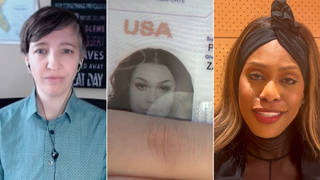
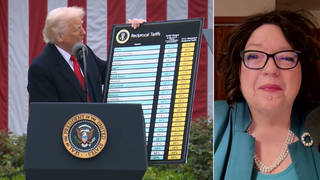
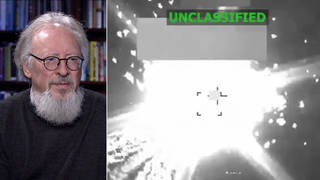
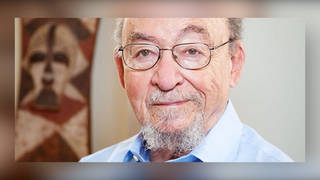





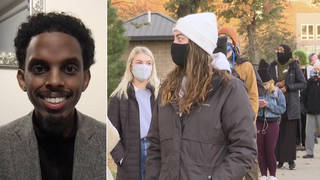
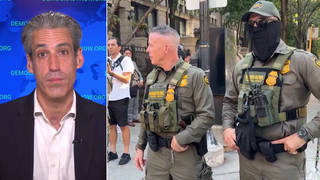
Media Options